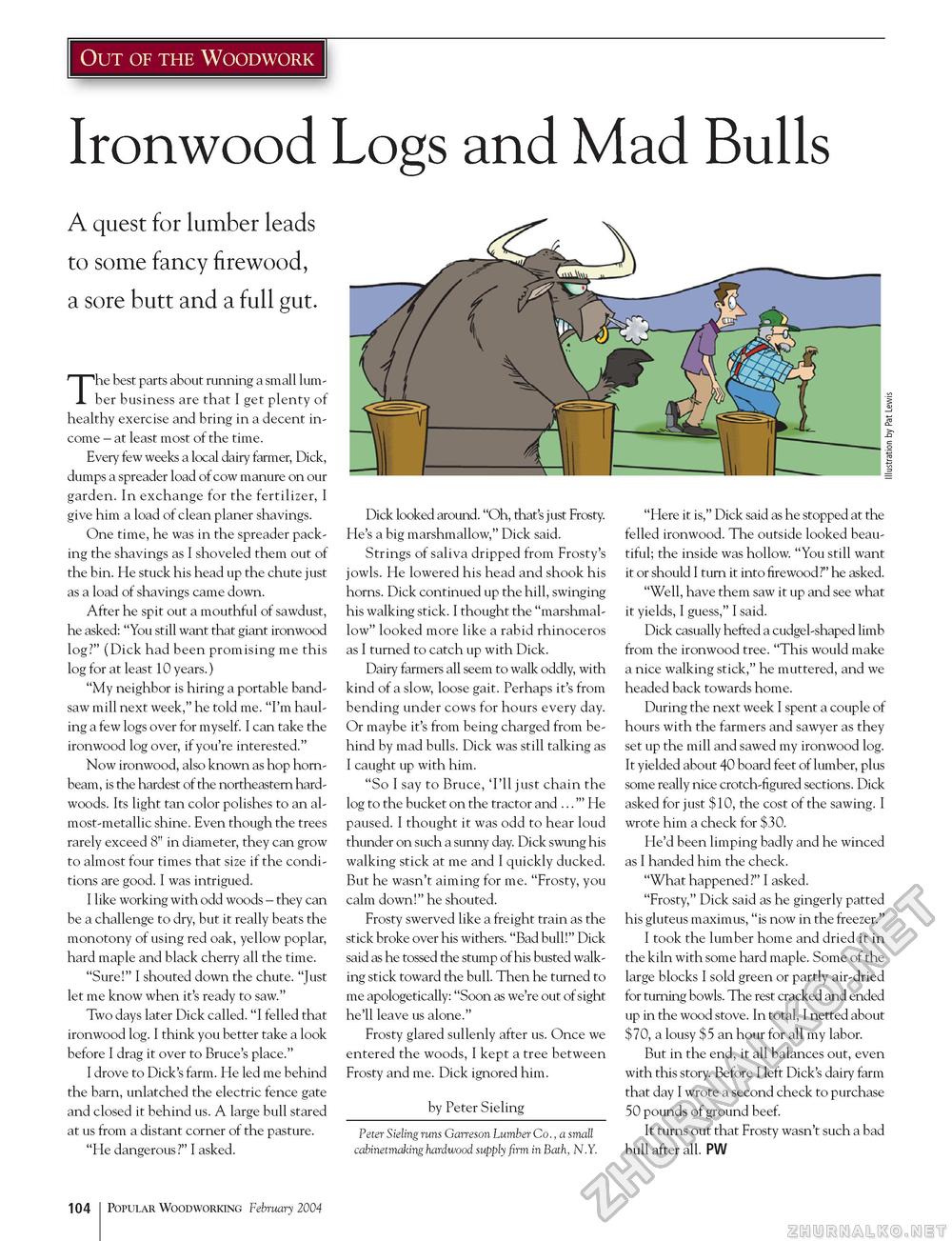Popular Woodworking 2004-02 № 139, страница 106
Out of the Woodwork Ironwood Logs and Mad Bulls A quest for lumber leads to some fancy firewood, a sore butt and a full gut. The best parts about running a small lumber business are that I get plenty of healthy exercise and bring in a decent income - at least most of the time. Every few weeks a local dairy farmer, Dick, dumps a spreader load of cow manure on our garden. In exchange for the fertilizer, I give him a load of clean planer shavings. One time, he was in the spreader packing the shavings as I shoveled them out of the bin. He stuck his head up the chute just as a load of shavings came down. After he spit out a mouthful of sawdust, he asked: "You still want that giant ironwood log?" (Dick had been promising me this log for at least 10 years.) "My neighbor is hiring a portable band-saw mill next week," he told me. "I'm hauling a few logs over for myself. I can take the ironwood log over, if you're interested." Now ironwood, also known as hop hornbeam, is the hardest of the northeastern hardwoods. Its light tan color polishes to an almost-metallic shine. Even though the trees rarely exceed 8" in diameter, they can grow to almost four times that size if the conditions are good. I was intrigued. I like working with odd woods - they can be a challenge to dry, but it really beats the monotony of using red oak, yellow poplar, hard maple and black cherry all the time. "Sure!" I shouted down the chute. "Just let me know when it's ready to saw." Two days later Dick called. "I felled that ironwood log. I think you better take a look before I drag it over to Bruce's place." I drove to Dick's farm. He led me behind the barn, unlatched the electric fence gate and closed it behind us. A large bull stared at us from a distant corner of the pasture. "He dangerous?" I asked. Dick looked around. "Oh, that's just Frosty. He's a big marshmallow," Dick said. Strings of saliva dripped from Frosty's jowls. He lowered his head and shook his horns. Dick continued up the hill, swinging his walking stick. I thought the "marshmal-low" looked more like a rabid rhinoceros as I turned to catch up with Dick. Dairy farmers all seem to walk oddly, with kind of a slow, loose gait. Perhaps it's from bending under cows for hours every day. Or maybe it's from being charged from behind by mad bulls. Dick was still talking as I caught up with him. "So I say to Bruce, 'I'll just chain the log to the bucket on the tractor and ...'" He paused. I thought it was odd to hear loud thunder on such a sunny day. Dick swung his walking stick at me and I quickly ducked. But he wasn't aiming for me. "Frosty, you calm down!" he shouted. Frosty swerved like a freight train as the stick broke over his withers. "Bad bull!" Dick said as he tossed the stump of his busted walking stick toward the bull. Then he turned to me apologetically: "Soon as we're out of sight he'll leave us alone." Frosty glared sullenly after us. Once we entered the woods, I kept a tree between Frosty and me. Dick ignored him. by Peter Sieling Peter Sieling runs Garreson Lumber Co., a small cabinetmaking hardwood supply firm in Bath, N.Y. "Here it is," Dick said as he stopped at the felled ironwood. The outside looked beautiful; the inside was hollow. "You still want it or should I turn it into firewood?" he asked. "Well, have them saw it up and see what it yields, I guess," I said. Dick casually hefted a cudgel-shaped limb from the ironwood tree. "This would make a nice walking stick," he muttered, and we headed back towards home. During the next week I spent a couple of hours with the farmers and sawyer as they set up the mill and sawed my ironwood log. It yielded about 40 board feet of lumber, plus some really nice crotch-figured sections. Dick asked for just $10, the cost of the sawing. I wrote him a check for $30. He'd been limping badly and he winced as I handed him the check. "What happened?" I asked. "Frosty," Dick said as he gingerly patted his gluteus maximus, "is now in the freezer." I took the lumber home and dried it in the kiln with some hard maple. Some of the large blocks I sold green or partly air-dried for turning bowls. The rest cracked and ended up in the wood stove. In total, I netted about $70, a lousy $5 an hour for all my labor. But in the end, it all balances out, even with this story. Before I left Dick's dairy farm that day I wrote a second check to purchase 50 pounds of ground beef. It turns out that Frosty wasn't such a bad bull after all. PW 104 Popular Woodworking February 2004 |







